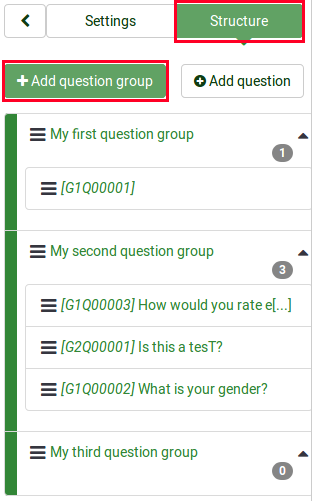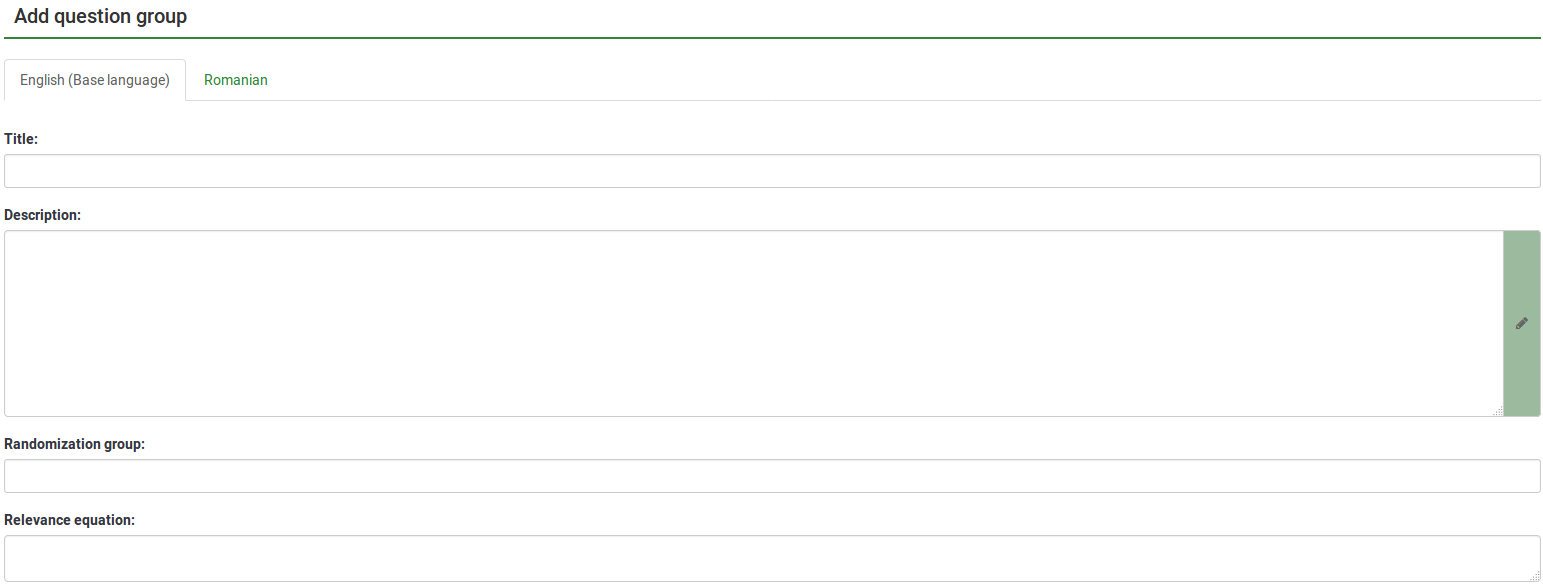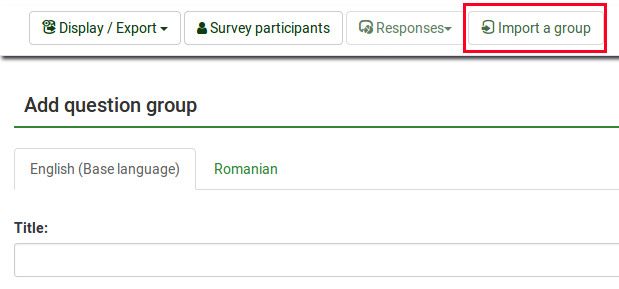Question groups - introduction: Difference between revisions
From LimeSurvey Manual
mNo edit summary |
mNo edit summary |
||
| Line 16: | Line 16: | ||
* Access | * Access the [[Survey structure|survey structure]] page and locate in the left menu the '''add question group''' button. | ||
| Line 27: | Line 27: | ||
<center>[[File:Add question group panel.png]]</center> | <center>[[File:Add question group panel.png]]</center> | ||
<!--T:4--> | |||
{{Box|'''You can create as many groups as you like!'''}} | |||
The following fields will be displayed: | The following fields will be displayed: | ||
| Line 32: | Line 35: | ||
<!--T:8--> | <!--T:8--> | ||
*Description: | *Description: This field allows you to publish an explanatory note for any set of questions. If you add a description, it will be presented at the survey before commencing any of the questions in that group. If no text is added, then public participants will simply move on to the survey questions. You can use the HTML editor to include images, formatted text, etc. to your liking; | ||
<!--T:13--> | <!--T:13--> | ||
*Ranzomization group: | *Ranzomization group: To start randomizing a question group, enter a string into the field such as ''randgroup1''. You will need to enter that same string in all question groups who you want to randomize and which will then appear in a random order when taking the survey. Only places <sup>inside</sup> the same group will be randomly switched! | ||
<!--T:10--> | <!--T:10--> | ||
*Relevance question: | *Relevance question: You can set in this field a "relevance equation" for the group with the help of the [[Expression Manager|Expression Manager]]. This is helpful for "looping" or other cases where you are repeating similar content multiple times. For example, say you want to ask the same set of follow-up questions for each child in a household and you have asked how many children are there via a question named ''numKids''. Then, for each group of follow-up questions, you would have to use relevance equations (which would collect data about the third child) such as: '''numKids == 3'''; | ||
<!--T:11--> | <!--T:11--> | ||
<div class="simplebox">[[File:help.png]] '''Note:''' An explanation and example for hiding question groups | <div class="simplebox">[[File:help.png]] '''Note:''' An explanation and example for hiding question groups are available in the [[Expression Manager Examples#Hide_question_group_if_answer_from_previous_question_is_Yes_or_No|Expression Manager examples wiki subsection]].</div> | ||
<!--T:6--> | <!--T:6--> | ||
<div class="simplebox">[[File:help.png]] '''Note:''' Groups can be used to group questions in a survey. If you are going to have multiple groups, you should note that by default the survey questions will be displayed group by group (you can change that at the survey settings). To display the groups in a particular order use the group re-ordering feature. If you have only one group in your survey then the name of this group is irrelevant (except of course for display).</div> | <div class="simplebox">[[File:help.png]] '''Note:''' Groups can be used to group questions in a survey. If you are going to have multiple groups, you should note that by default the survey questions will be displayed group by group (you can change that at the survey settings). To display the groups in a particular order use the group re-ordering feature. If you have only one group in your survey then the name of this group is irrelevant (except of course for display).</div> | ||
==Add question group toolbar== | |||
You may find on the top toolbar the following options: | |||
<center>[[File:]]</center> | |||
* Display/Export | |||
* Survey participants | |||
* Responses | |||
* [[Import a question group|Import a group]]: Besides the two ways [[mentioned above]], new question groups can also be added via the [[Import a question group|import group function]]. | |||
===Import a question group=== | |||
You can also import a question group (.lsg file format) that was previously exported from a LimeSurvey survey. First, access the '''add question group''' option and then locate on the top toolbar the import question group function: | |||
<center>[[File:Import question group 1.png]]</center> | |||
Browse your computer/server and upload the .lsg file that contains the question group you wish to import. | |||
Revision as of 19:19, 14 December 2017
Create question group
There are two ways through which you can start adding question groups to your survey:
- Access the Overview tab from the survey settings menu. Locate the add new group button in the Survey summary section and create your question group:
- Access the survey structure page and locate in the left menu the add question group button.

Once created, the add question group panel will be showed up:

You can create as many groups as you like!
The following fields will be displayed:
- Title: Type in this box the name you wish to give to the question group;
- Description: This field allows you to publish an explanatory note for any set of questions. If you add a description, it will be presented at the survey before commencing any of the questions in that group. If no text is added, then public participants will simply move on to the survey questions. You can use the HTML editor to include images, formatted text, etc. to your liking;
- Ranzomization group: To start randomizing a question group, enter a string into the field such as randgroup1. You will need to enter that same string in all question groups who you want to randomize and which will then appear in a random order when taking the survey. Only places inside the same group will be randomly switched!
- Relevance question: You can set in this field a "relevance equation" for the group with the help of the Expression Manager. This is helpful for "looping" or other cases where you are repeating similar content multiple times. For example, say you want to ask the same set of follow-up questions for each child in a household and you have asked how many children are there via a question named numKids. Then, for each group of follow-up questions, you would have to use relevance equations (which would collect data about the third child) such as: numKids == 3;
Add question group toolbar
You may find on the top toolbar the following options:
- Display/Export
- Survey participants
- Responses
- Import a group: Besides the two ways mentioned above, new question groups can also be added via the import group function.
Import a question group
You can also import a question group (.lsg file format) that was previously exported from a LimeSurvey survey. First, access the add question group option and then locate on the top toolbar the import question group function:

Browse your computer/server and upload the .lsg file that contains the question group you wish to import.